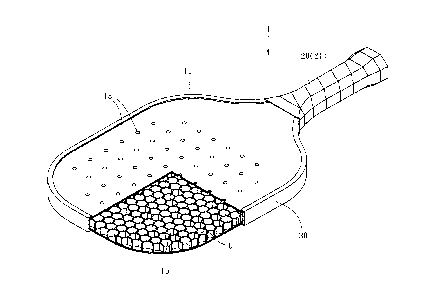Some of the information on this Web page has been provided by external sources. The Government of Canada is not responsible for the accuracy, reliability or currency of the information supplied by external sources. Users wishing to rely upon this information should consult directly with the source of the information. Content provided by external sources is not subject to official languages, privacy and accessibility requirements.
Any discrepancies in the text and image of the Claims and Abstract are due to differing posting times. Text of the Claims and Abstract are posted:
| (12) Patent Application: | (11) CA 3038087 |
|---|---|
| (54) English Title: | LIGHTWEIGHT PICKLEBALL PADDLE |
| (54) French Title: | RAQUETTE LEGERE DE TENNIS LEGER |
| Status: | Deemed Abandoned and Beyond the Period of Reinstatement - Pending Response to Notice of Disregarded Communication |
| (51) International Patent Classification (IPC): |
|
|---|---|
| (72) Inventors : |
|
| (73) Owners : |
|
| (71) Applicants : |
|
| (74) Agent: | OSLER, HOSKIN & HARCOURT LLP |
| (74) Associate agent: | |
| (45) Issued: | |
| (22) Filed Date: | 2019-03-26 |
| (41) Open to Public Inspection: | 2020-09-26 |
| Examination requested: | 2019-03-26 |
| Availability of licence: | N/A |
| Dedicated to the Public: | N/A |
| (25) Language of filing: | English |
| Patent Cooperation Treaty (PCT): | No |
|---|
| (30) Application Priority Data: | None |
|---|
A pickelball paddle includes a rectangular ball-hitting portion providing a
short side
ranged from 7 inches to 8.75 inches in length and a long side ranged from 9.5
inches to 12
inches in length, and a grip portion connected with the ball-hitting portion
and ranged from 4
inches to 5.5 inches in length. The ball-hitting portion is constructed of a
first surface layer, a
second surface layer, an inner layer disposed between the first and second
surface layers and
defining a honeycomb shape in cross-section, and a plurality of through holes
passing straight
through the first and second surface layers and the inner layer. As a result,
the honeycomb
shaped inner layer is used for reducing the weight of the whole structure, and
the through holes
are used for assisting air to flow through the ball-hitting portion for
reducing wind resistance
when the pickelball paddle is swung.
Note: Claims are shown in the official language in which they were submitted.
Note: Descriptions are shown in the official language in which they were submitted.

2024-08-01:As part of the Next Generation Patents (NGP) transition, the Canadian Patents Database (CPD) now contains a more detailed Event History, which replicates the Event Log of our new back-office solution.
Please note that "Inactive:" events refers to events no longer in use in our new back-office solution.
For a clearer understanding of the status of the application/patent presented on this page, the site Disclaimer , as well as the definitions for Patent , Event History , Maintenance Fee and Payment History should be consulted.
| Description | Date |
|---|---|
| Application Not Reinstated by Deadline | 2022-08-16 |
| Inactive: Dead - No reply to s.86(2) Rules requisition | 2022-08-16 |
| Letter Sent | 2022-03-28 |
| Deemed Abandoned - Failure to Respond to an Examiner's Requisition | 2021-08-16 |
| Examiner's Report | 2021-04-16 |
| Inactive: Adhoc Request Documented | 2021-03-15 |
| Inactive: Office letter | 2021-03-15 |
| Inactive: Delete abandonment | 2021-03-15 |
| Inactive: Correspondence - Prosecution | 2021-02-16 |
| Common Representative Appointed | 2020-11-07 |
| Application Published (Open to Public Inspection) | 2020-09-26 |
| Inactive: Cover page published | 2020-09-25 |
| Deemed Abandoned - Failure to Respond to an Examiner's Requisition | 2020-08-31 |
| Inactive: COVID 19 - Deadline extended | 2020-08-19 |
| Examiner's Report | 2020-04-23 |
| Inactive: Report - No QC | 2020-03-27 |
| Common Representative Appointed | 2019-10-30 |
| Common Representative Appointed | 2019-10-30 |
| Inactive: Filing certificate - RFE (bilingual) | 2019-04-05 |
| Filing Requirements Determined Compliant | 2019-04-05 |
| Inactive: IPC assigned | 2019-04-03 |
| Inactive: First IPC assigned | 2019-04-03 |
| Inactive: IPC assigned | 2019-04-03 |
| Inactive: IPC assigned | 2019-04-03 |
| Inactive: IPC assigned | 2019-04-03 |
| Letter Sent | 2019-04-01 |
| Application Received - Regular National | 2019-03-28 |
| Request for Examination Requirements Determined Compliant | 2019-03-26 |
| All Requirements for Examination Determined Compliant | 2019-03-26 |
| Abandonment Date | Reason | Reinstatement Date |
|---|---|---|
| 2021-08-16 | ||
| 2020-08-31 |
The last payment was received on 2021-01-07
Note : If the full payment has not been received on or before the date indicated, a further fee may be required which may be one of the following
Please refer to the CIPO Patent Fees web page to see all current fee amounts.
| Fee Type | Anniversary Year | Due Date | Paid Date |
|---|---|---|---|
| Application fee - standard | 2019-03-26 | ||
| Request for examination - standard | 2019-03-26 | ||
| MF (application, 2nd anniv.) - standard | 02 | 2021-03-26 | 2021-01-07 |
Note: Records showing the ownership history in alphabetical order.
| Current Owners on Record |
|---|
| YMA CORPORATION |
| Past Owners on Record |
|---|
| JING-BIN CHIANG |